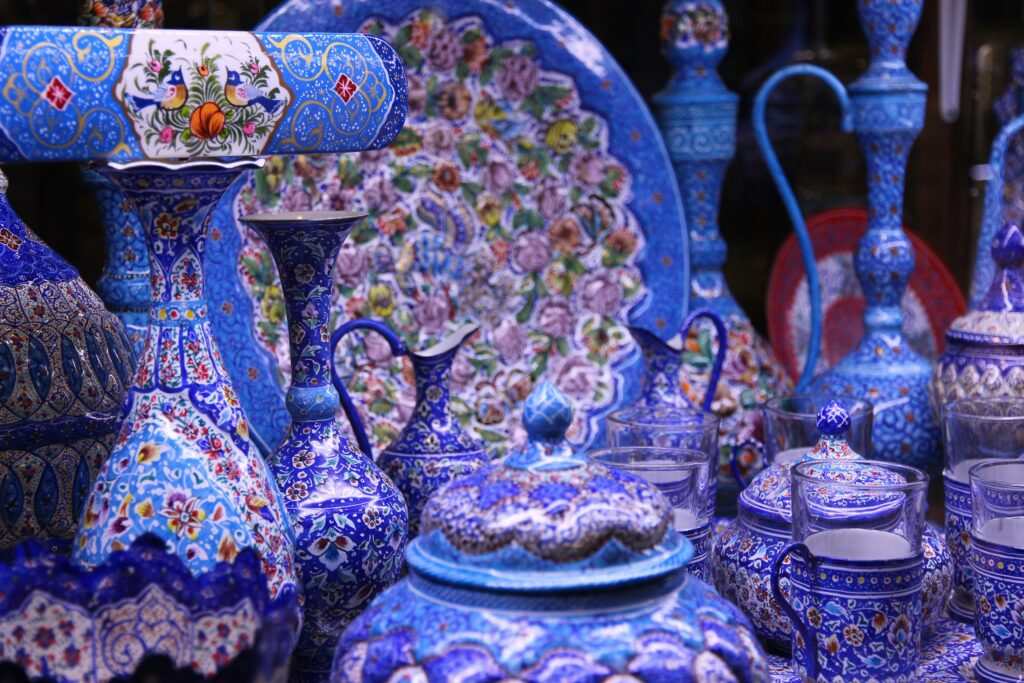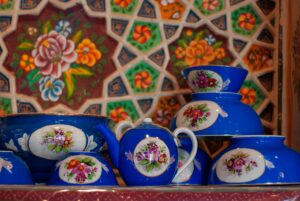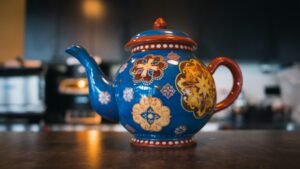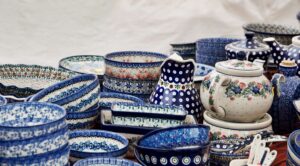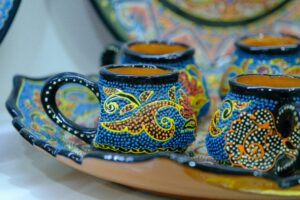
There is a craft in the heart of South Asia that is so ancient, so complex, and which I still forget almost as much – Multani Blue Pottery ceramics. Once in Multan (now in Pakistan), a vibrant symbol of artistry and cultural identity, this unique form of ceramic art has been seen for centuries, falling, and now, a remarkable revival. The story of multi-blue ceramics is not just about mud and glass cover; It is about tradition, flexibility, and a modern ceramic revolution that breathes new life into this lost art.
This article explains how a craft was once used to beautify the Mughal palaces and the Sufi Pilgrims, and now experiences a renaissance, not only as cultural objects, but also as a symbol of permanent design, artistic innovation, and heritage protection.
Table of Contents
1. Origins of Multani Blue Pottery – A Legacy Etched in Clay
Multani Blue Pottery dates from more than 700 years, lies in the rich cultural intersection of Persia, Central Asia, and India. While blue-glazed ceramics were common in the Islamic world, it was in Multan, a city that was excellent as a spiritual and commercial center, that this craft could recognize its own.
Multani craftsmen developed a unique formula using ground quartz, glass, and white clay, which creates a smooth, translucent body as opposed to a traditional soil pot. This enables geometric designs painted in complex floral patterns and geometric cobalt blue, turquoise,e and indigo tremendously.
During the Mughal era, the Mughal ceramics reached their area. This adorned the walls of mosques, graves, and royal buildings from Lahore to Delhi. However, with the fall of the Mughal Empire and the emergence of British colonial authorities, the protection and the craft gradually faded into ambiguity.
By the mid-1900s, Multani-Blå pottery became a relic of historical techniques and is only known for a handful of craftsmen.
2. The Fall and Fading Echoes of a Glorious Craft
As industrialization swept through South Asia, the craftsmen were for large alternatives. The delicate process of making muslin blue pottery, which requires weeks of preparation, skilled hands, and rare material, could not compete with cheap, fast production methods.
In addition, in 1947, India’s partition and craftsman communities were disturbed. Many potmakers migrated or left their craft. The knowledge from the master of the trainee began to disappear.
In the late 1900s, Multani-Blå pottery was considered a dying art, with which some doctors were released and even smaller buyers. The museums preserved parts of their beauty, but the living tradition was lost forever.
3. The Ceramic Revolution Begins – Rediscovering a Lost Art
But the story didn’t end there.
A cool movement began at the beginning of the 2000s, led by art historians, designers, and emotional individuals who saw the value of reviving Muli Blue Pottery. What started as an academic interest soon became action.
One of the crucial moments came when architects and protectionists who restored historical places in Lahore and Multan felt the importance of authentic material and crafts. He searched for the survival craftsmen and revived the old ovens. This effort gave rise to a ceramic revolution – not only in preserving the past, but also to secure the future of this art.
Today, organizations such as the National College of Arts (NCA) in Lahore have taken mental, along with private attitudes, and voluntary organizations. They train new generations of artists, experiment with modern applications, and integrate Multani motifs into modern architecture, fashion, and home decorations.
4. Techniques and Traditions – The Soul of Multani Blue Pottery
Revival of Multani Blue Pottery was not just about apathy – it was about understanding and preserving the technical talent behind each piece.
Unlike traditional soil equipment, multi-blue ceramics are made of non-cleaning materials, made of a mixture:
Quartz powder
Glass
White clay (China Clay)
Rubber arabic
This gives the end product a vitreous, light quality, which is perfect for wide cutting and glass. The pieces are covered by hand, dried in the sun, and removed at low temperatures, making them delicate and durable.
The craftsmen then paint wide flowers, calligraphy inscriptions, and geometric patterns using a mineral-based pigment. Each color has a symbolic meaning – blue represents divinity, a symbol of green nature, and gold reflects royalty.
The whole process can take weeks, and emphasizes patience, accuracy,y and passion – built into the soul of Multani blue ceramics.
5. Modern Renaissance – How Contemporary Design is Fueling the Ceramic Revolution
The resuscitation of multi-blue ceramics is not limited to museums or historical reconstructions. Today it is revived in the modern world.
Designers are involved in Multi Patterns:
Internal decoration (wall tiles, valences, lamps)
Fashion products (handbags, jewelry boxes)
Architectural restoration (mosques, hotels, luxury houses)
Young entrepreneurs launch brands that mix traditional crafts with global aesthetics. Social media platforms such as Instagram and Pinterest have also played a role in showing these works to an international audience.
In addition, environmentally conscious consumers are prepared for the stability of handmade, non-industrial processes. With the use of toxic chemicals and minimal carbon footprints, multi-blue ceramics are fully adjusted with slowly vibrant and moral consumption movements.
6. Challenges and Opportunities – Keeping the Flame Alive Multani Blue Pottery
Despite the rising speed, the ceramic revolution is still against obstacles.
Lack of skilled craftsmen
High production costs
Limited market awareness
Competition with cheap cheating
Government support, craft training, also requires better infrastructure and strong branding strategies to ensure long-term viability.
However, the opportunity is surprising:
Tourism and cultural diplomacy can demonstrate Multani blue ceramics globally.
Education programs and workshops can motivate young talents to take up crafts.
Organizations such as UNESCO and the World Monuments Fund have recognized the importance of security for such abstract inheritance, which provides hope of institutional support.
7. Voices from the Kiln – Stories of Revival and Hope
Multani is the human history behind every piece of blue ceramics.
Meet Shahid Hussain, a third-generation postman, who almost left the family’s business for a university project and rejected his passion. Now he runs a small workshop in Lahore, teaches students, and delivers custom tiles to luxury hotels.
Or Zara Khan, a young designer, who melts
These stories reflect a broader tendency: empowerment of local communities through cultural revival.
When people see value in the legacy, they fight to preserve it. And when that legacy becomes economically viable, it changes life.
8. Embracing the Multani Blue Pottery of Tomorrow
Multani Blue Pottery Travel – from Royal Courts to Exhalation, and now for a living revival – is a powerful story of flexibility, reinforcement, and rebirth.
This challenges us to consider what progress means. It invites us to slow down, look more closely, and appreciate the depth of the tradition that lies below the surface of each tile, plate, and vase.
So the next time you see a piece of blue ceramics in light, remember: You don’t just look at the art – you see a ceramic revolution, respecting the past while you shape the future.
9. Call to Action: Be Part of the Multani Blue Pottery Revolution
Are you inspired by the resuscitation of multani-blue pottery? Support the movement of:
Ethn
Share your stories on social media
Visit of cultural exhibitions
To support a nomination or educational initiative in workshops
Together we can keep this beautiful art alive – and make sure that the future generations inherit not only memories, but living traditions.
What is Multani Blue Pottery?
Multani Blue Pottery is a traditional form of glazed ceramic art originating from Multan, Pakistan. It’s known for its signature cobalt blue color, intricate floral and geometric designs, and use of quartz-based clay.
How old is this craft?
It dates back over 700 years, with roots in Persian, Central Asian, and Indian artistic traditions. It flourished during the Mughal era and was used to decorate mosques, palaces, and tombs.
Why did it almost disappear?
Due to industrialization, migration during Partition (1947), and lack of patronage, the craft declined. Many artisans left the trade, and knowledge passed down through generations began to vanish.

